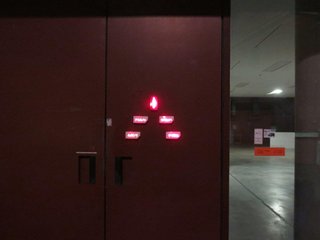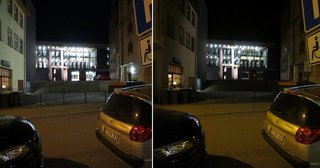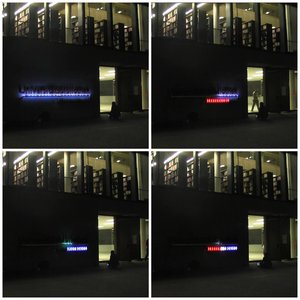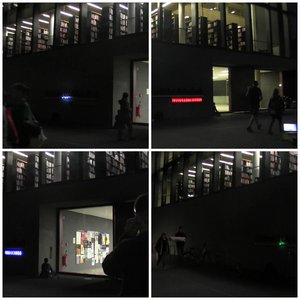Models and Cases of media in the city
In order to get an understanding of the domain of Urban HCI, students were creating a demo database which was able to list projects in regard to existing theoretical frameworks of public interactions. For example, the design space explorere by Dalsgaard lists the properties material, form, situation, location, interaction, content, and purpose. CMS users than were able to use these frameworks to filter public media installations. With this our students gained knowledge about theory and types of content.
The project in itself focused on content and how display media can be 'shaped' to tell a story.
In-Situ Content Type Testing

To understand the effect of size, speed, text, gestalt, basic shapes, resolution and pixel pitch, we tested a number of different projections at the university library in-situ. To evaluate impressions created by the projection two study approaches were taken. One was called Free-to-Roam (FTR) the other Experiential Sampling (ES).
For the FTR method participants were asked to explore the environment and note down any interesting observation and their position whenever they feel they have to. This was done for two different setups and eleven different projections of content.
The ES method defined 4-5 sampling positions for which the probants then had to rate twelve semantic differentials. This was done for three different setups (thoroughfare situation, plaza and hybrid).


Simulation vs. In-Situ Testing
Different from real world paper maps, the simulation stored the exact georeference position automatically whenever the testers took a note, enabling the testers to focus on finding interesting views. The resulting data shows, that the simulation based test on average was 3 times faster (about 3min. per test content) than the in-situ test. The figure above shows the distribution of position-points, where testers took notes in-situ and in the simulation. Shared areas (determined as interesting by testers in both conditions) are marked in turquoise. “Blind” zones (grey) extend to the left and right. The figure also shows the difference; many in-situ points lay in a courtyard area whereas testers in the simulation were interested in positions on and near the street area. This is probably because the simulation has no traffic and this area thus is safer than in real lifr, making testers curious to explore this view.
Prototyping
To explore alternative ways to convey content, two groups developed their own versions of a display. Based on the idea of urban story telling, the content influenced the design of the hardware as well as the hardware desing influenced the story content.
The module group's story is based on the 'flame of wisdom'. It is a the light of the flame enlightens the environment the more books are borrowed from the library.If there are only few books borrowed, only one module is displaying content. The more books are out, the more modules are used for the content and the bigger the flame displayed.

Weiterführende Links:
Dataexplorer Free-to-Roam Setup 1
Dataexplorer Free-to-Roam Setup 2
Projektteilnehmer:
Mohammed Hanafy
Muzzaffar Ali
Ekaterina Fuchkina
Nguyen Thien Chinh
Betreut durch:
Prof. Dr.-Ing. Eva Hornecker
Dr. Patrick Tobias Fischer




